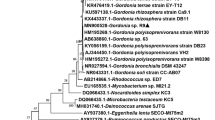Abstract
A bacterial strain, ZY3, growing on sex steroid hormones as the sole source of carbon and energy was isolated from the sewage treatment plant of a prophylactic steroids factory. ZY3 degrades the 3-methoxy-17β-hydroxy-1,3,5(10),8(9)-δ-4-estren (MHE). This strain was preliminarily identified as Raoultella sp. ZY3 according to its morphology and its 16S rRNA gene sequence. During the experimental period (72 h), the optimum temperature, pH and 3-MHE concentration for the degradation of hydride by the strain ZY3 were 35°C, 10 and 10 mg/L, respectively. The degradation rate of the sex steroid hormones increased to 87% and 85% after the addition of maltose and peptone, respectively.
Similar content being viewed by others
References
Baronti C, Curini R, D’Ascenzo G, Corcia A D, Gentili A, Samperi R. Monitoring natural and synthetic estrogens at activated treatment plants and in receiving river water. Environ Sci Technol, 2000, 34(24): 5059–5066
Belfroid A C, Van der Horst A, Vethaak A D, Schafer A J, Rijs G B J, Wegener J, Cofino W P. Analysis and occurrence of estrogenic hormones and their glucuronides in surface water and waste water in the Netherlands. Sci Total Environ, 1999, 225(2): 101–108
Snyder S A, Keith T L, Verbrugge D A, Snyder E M, Gross T S, Kannan K, Giesy J P. Analytical methods for detection of selected estrogenic compounds in aqueous mixtures. Environ Sci Technol, 1999, 33(16): 2814–2820
Ternes T A, Stumpf M, Mueller J, Haberer K, Wilken R D, Servo M. Behaviour and occurrence of estrogens in municipal sewage treatment plants-I. Investigations in Germany, Canada and Brazil. Sci Total Environ, 1999, 228(1): 81–90
Nasu M, Goto M, Kato H, Oshima Y, d Tanaka H. Study on endocrine disrupting chemicals in wastewater treatment plants. Water Sci Technol, 2000, 43(2): 101–108
Ren H Y, Ji S L, Cui C W. The pollution aspects and the removal way of sex steroid hormone. China Water & Wastewater, 2004, 20(12): 24–26 (in Chinese)
Vader J S, Van Ginkel C G, Sperling F M G M, De Jong J, De Boer W, De Graaf J S, Van der Most M, Stokman P G W. Degradation of ethynyl-estradiol by nitrifying activated sludge. Chemosphere, 2000, 41(8): 1239–1243.
Liu Z P, Yang H F, Zhou P J. Characterizations and the metabolism pathway of microbial degradation of aniline. Chinese Journal of Applied & Environmental Biology, 1999, 12(5): 5–9 (in Chinese)
Desbrow C, Routledge E J, Brighty G C, Sumpter J P, Waldock M. Identification of estrogenic chemicals in STW effluent: 1. Chemical fractionation and in vitro biological screening. Environ Sci Technol, 1998, 32(11): 1549–1558
Author information
Authors and Affiliations
Corresponding author
Additional information
Translated from China Environmental Science, 2005, 25(5): 585–588 [译自: 中国环境科学]
Rights and permissions
About this article
Cite this article
Ji, S., Liu, Z., Liu, Z. et al. Isolation and characterization of a bacterial strain that efficiently degrades sex steroid hormones. Front.Environ.Sci.Eng.China 1, 325–328 (2007). https://doi.org/10.1007/s11783-007-0055-8
Issue Date:
DOI: https://doi.org/10.1007/s11783-007-0055-8




